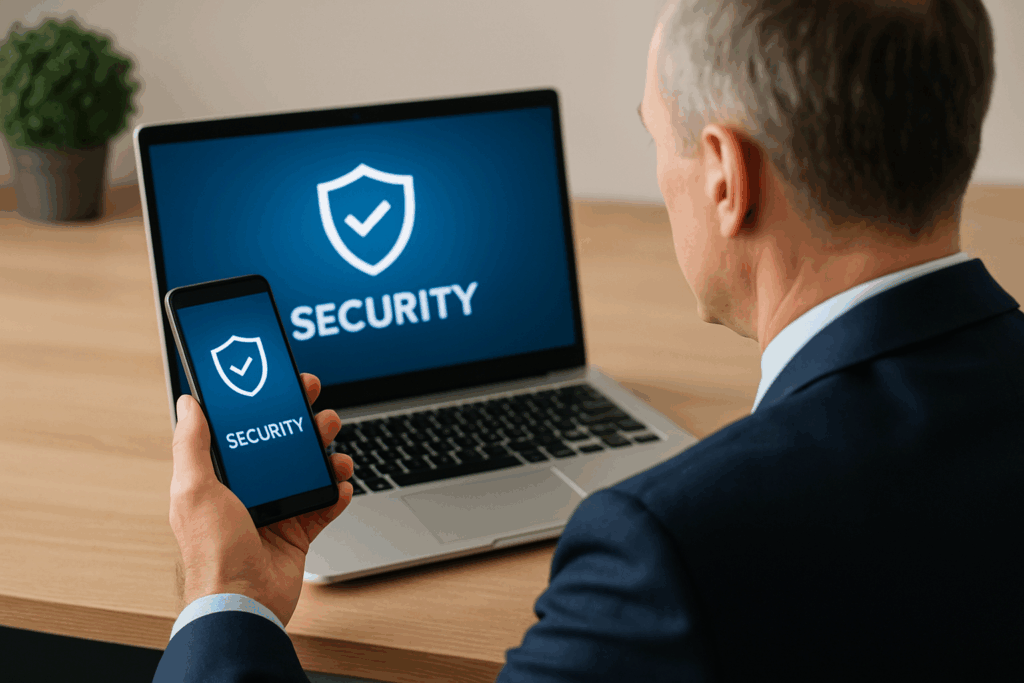
Cybercriminals no longer see CEOs and senior leaders as just another target; they see them as the jackpot. A 2024 Verizon DBIR report noted that executives were five times more likely than regular employees to be the subject of social engineering attacks.
With their influence, access to sensitive data, and high public visibility, the C-Suite presents a larger attack surface than most organizations are aware of.
Cyber hygiene, in this context, isn’t just about personal security routines. It refers to the ongoing, proactive security measures that keep accounts, devices, and information safe both inside and outside the office.
For executives, this discipline must encompass corporate systems, personal digital life, and even family members whose online behavior can open new avenues for attackers.
This guide provides practical executive cybersecurity tips, modern threat insights, and policy recommendations that enhance executive data protection and online safety across all devices. By the end, you will know how CEOs can stay safe online without drowning in jargon.
Why Executives Are Prime Targets
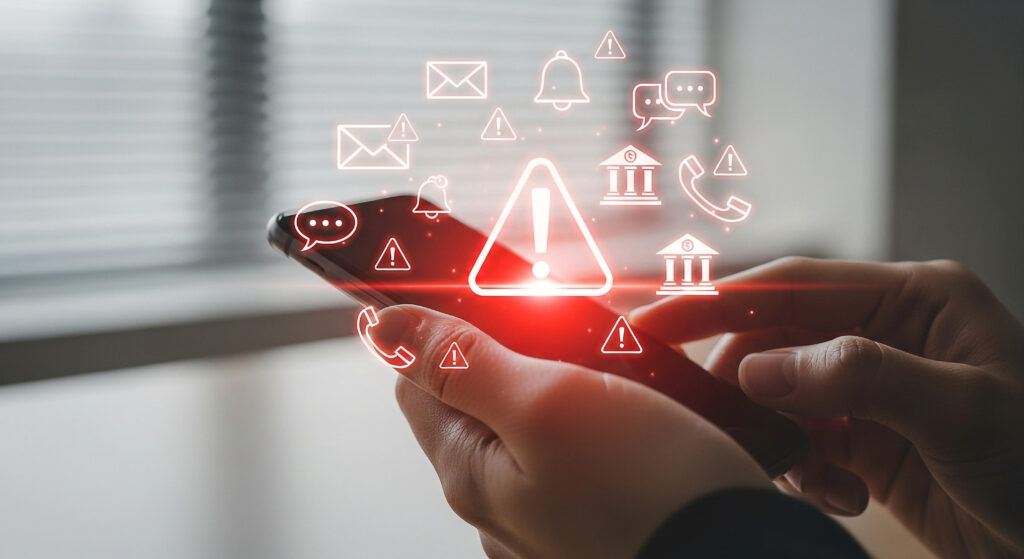
Executives represent a high-value target for attackers, and the reasons extend well beyond financial gain.
Here’s what makes you more exposed:
- Expanded attack surface. A CEO’s digital footprint stretches across corporate systems, personal email accounts, social media profiles, and public appearances. Each of these channels provides criminals with an opportunity to exploit.
- High-value breach potential. Senior leaders have direct or indirect access to deals in progress, M&A strategies, board communications, financial statements, and intellectual property. Compromising just one account can put all of this at risk.
- Social engineering leverage. Few roles carry as much trust and influence as a CEO or CFO. Attackers impersonating executives can trick staff into wiring funds, releasing sensitive documents, or even altering strategic decisions.
- Brand damage risk. Beyond theft, attackers aim for maximum disruption. A compromised executive account used to spread false information or leak data can cause reputational harm that impacts stock prices, investor trust, and customer confidence.
The Modern Threat for C-Suite Leaders
The risks facing executives today are significantly different from what they were five years ago. Attackers now combine social engineering with AI tools, mobile exploits, and data mining to craft targeted, personalized strikes.
Here are some of the main threats executives should keep in view:
- Phishing 3.0. Basic “Nigerian prince” scams are long gone. Attackers now use AI to create emails, calls, or even video deepfakes that sound and appear to be from a trusted colleague. These highly polished spear-phish attempts are far harder to spot.
- Account Takeovers (ATO). Business email, cloud storage, and collaboration tools are prime targets for cyberattacks. Once attackers gain access to an executive account, they can spy on strategy, send fake directives, or steal confidential documents.
- Data Broker Exposure: Executives leave a digital trail harvested by data brokers, which includes sensitive details like addresses, phone numbers, and family information. Criminals then buy this data to mount doxxing campaigns, engage in stalking, or create sophisticated phishing lures.
- SIM-Swap and MFA Fatigue Attacks. Mobile numbers are often a soft underbelly. Criminals trick carriers into swapping a SIM card, hijack SMS codes, or bombard users with MFA prompts until they click “approve.”
- Travel Risks. Airports, hotels, and conference centers are fertile ground for attackers. Insecure Wi-Fi, malicious charging stations, and geo-tagged social posts make it easier for criminals to track and exploit executives abroad.
- Supply Chain Infiltration. Attackers also exploit individuals who serve executives, such as lawyers, accountants, PR teams, or even household staff. A breach at one of these points can provide an indirect route into corporate systems.
Cyber Hygiene Fundamentals for Executives
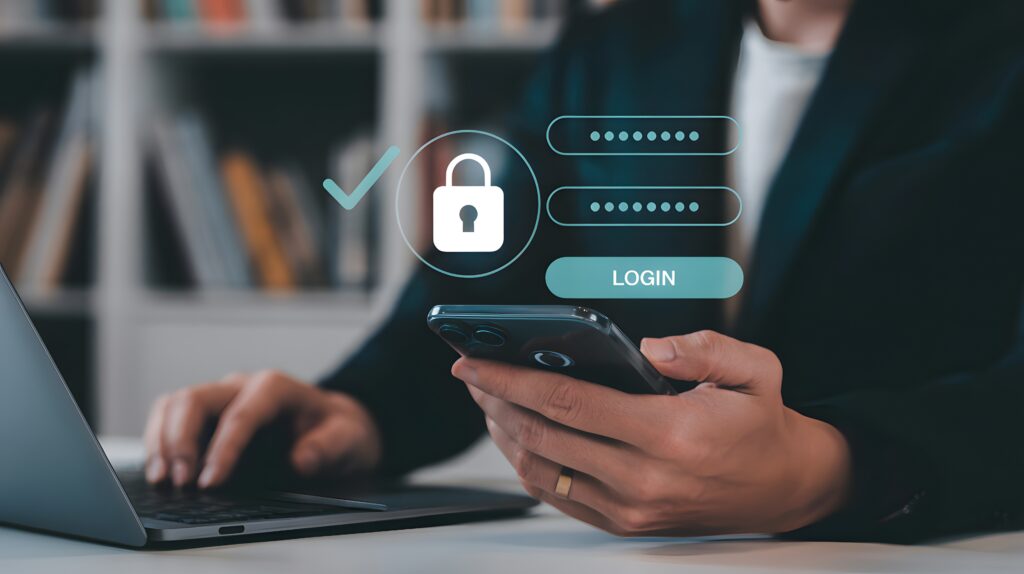
For senior leaders, cyber hygiene is about consistency. It’s not one silver bullet but a set of layered habits that cut off easy entry points. Here are some great fundamentals every executive should adopt:
Password & Access Hygiene
Weak or reused credentials remain the easiest way in for attackers. To reduce risk:
- Use unique passphrases for every account, stored in a corporate-approved password manager.
- Require phishing-resistant MFA, such as hardware security keys or authenticator apps, since SMS codes are too easily intercepted.
- Schedule quarterly credential audits, closing unused accounts, and checking for exposures on dark web monitoring tools.
Device Security
Executives often use multiple devices (laptops, tablets, and phones) across personal and corporate settings. That mix creates blind spots unless secured properly. To avoid this, do the following:
- Encrypt all devices with full-disk encryption so data stays protected even if hardware is lost or stolen.
- Apply OS and security patches quickly, ideally within 48 hours of release. Unpatched devices are a magnet for opportunistic malware.
- Run endpoint detection and response (EDR) on every executive device to spot suspicious activity before it spreads.
Network Hygiene
Because executives are highly mobile and frequently work from airports, hotels, and homes where network security is often weak, implementing safer practices is important. These practices include:
- Connect only through corporate VPNs or zero-trust network access. This ensures traffic is encrypted and monitored.
- Avoid public Wi-Fi. If you must connect, tether through a secure mobile connection instead.
Email & Communication
Email and messaging are high-value targets because they combine sensitive content with direct authority. Safer communication hygiene means:
- Stick to corporate-controlled, encrypted email accounts and messaging apps.
- Never forward corporate documents to personal accounts, which are rarely monitored or protected at the same level.
Securing the Executive Digital Footprint
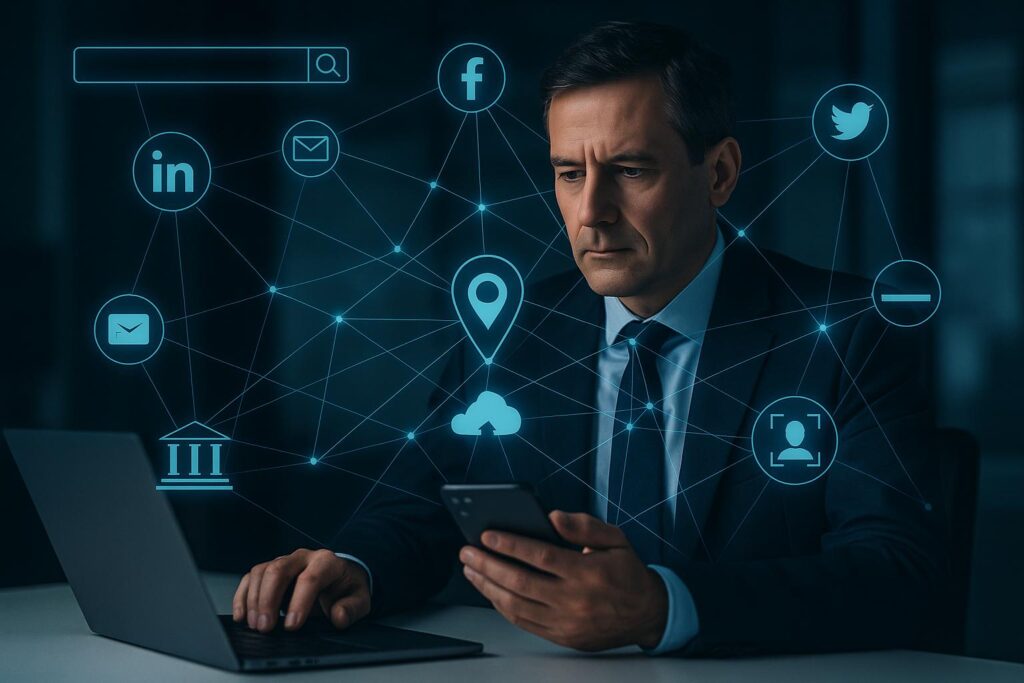
For executives, risk doesn’t stop at the office firewall. Your entire online presence, including social media, past registrations, and public records, is a goldmine for criminals.
To reduce exposure and lock down your digital footprint, do the following:
- Audit social media profiles. Review LinkedIn, Instagram, X, and Facebook accounts at least twice a year. Strip out unnecessary personal details (family names, home addresses, geotags) and adjust privacy settings so only trusted contacts can see sensitive information.
- Remove yourself from data brokers. Services like Spokeo, Whitepages, and PeopleFinder trade executive data that fuels doxxing and targeted scams. Opt-out services, or manual removal campaigns, shrink the pool of exploitable information.
- Register lookalike domains. Criminals often create fake websites or email domains (like johndoe-company[dot]com) to impersonate leaders. Proactively registering these domains makes it harder for attackers to weaponize them.
- Set up Google Alerts and monitoring tools. Automated alerts for your name, email, and company help flag suspicious activity fast. Pair this with dark web monitoring for exposed credentials or mentions of executive data.
Travel & Remote Work Security Protocols
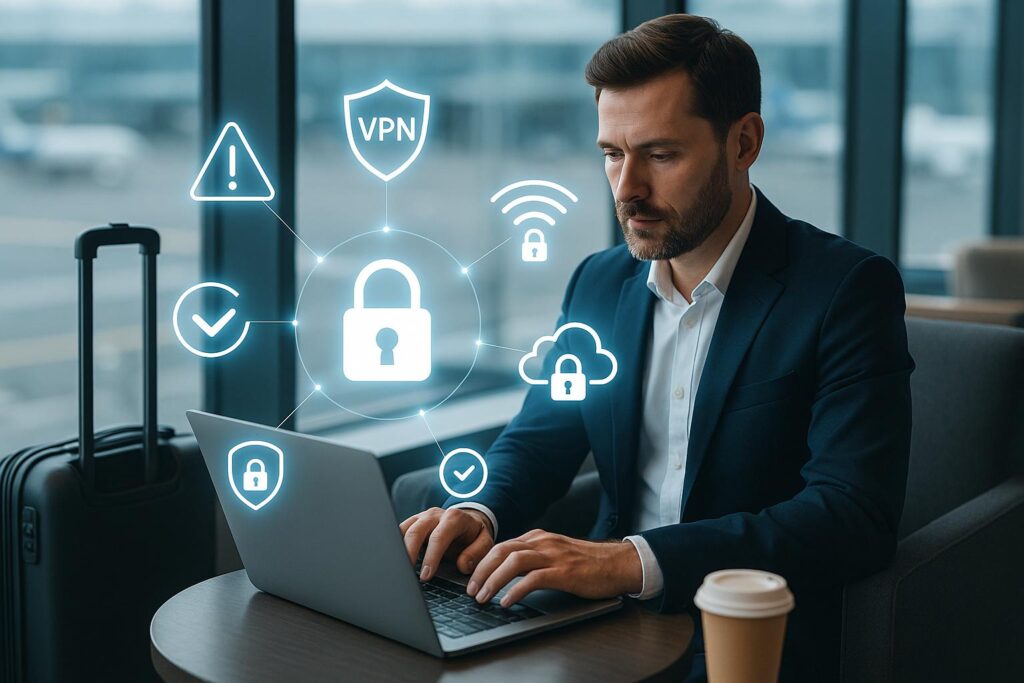
Executives often move fast, hopping between airports, boardrooms, hotels, and events. Because this flexibility comes with increased exposure, here are some great habits that will protect your data while you’re on the go:
Before Travel
- Prep travel devices. Avoid carrying your daily-use laptop packed with sensitive files. So use a travel-only device that’s wiped and preloaded with only what’s necessary.
- Back up your data. If something goes wrong, you’ll want to recover quickly. Use encrypted cloud backups for anything critical.
- Update emergency contacts. Make sure your security team or assistant has your updated itinerary and contact options in case something goes sideways.
During Travel
- Avoid hotel Wi-Fi and public charging stations. These can be spoofed or compromised. Instead, tether to a mobile hotspot and carry your own charger with AC power.
- Disable location services on apps that don’t need them. Oversharing via real-time location tracking opens the door to physical risk and social engineering.
- Use secure communication apps. Stick to company-approved encrypted apps for calls, messages, and file sharing, not public messengers or email.
After Travel
- Scan your devices. Run malware and threat scans on any device used outside the corporate network, even if nothing looks suspicious.
- Change passwords for key accounts accessed while abroad especially if you logged in from shared devices or new locations.
- Report anomalies. If you notice any red flags, such as suspicious Wi-Fi behavior or strange login alerts, notify your security team right away. It’s easier to catch and contain threats when context is reported early.
Executive Incident Response: First 72 Hours

When an executive account or device is compromised, the speed of your response in the first few hours is absolutely critical. If you delay your response, you give attackers a larger window to dig in, spread laterally, or weaponize stolen data.
So if you suspect a compromise, act fast. Don’t wait for confirmation or internal “triage.” Your first job is containment.
Here’s a clear response sequence:
- Isolate the device. Unplug from networks, disable Wi-Fi, and do not keep using it. If it’s a phone or tablet, switch it to airplane mode immediately.
- Alert your CISO or security lead. Don’t go it alone. Let internal teams take over and guide next steps, including forensics and user notification.
- Rotate all credentials. Reset passwords for email, cloud platforms, financial tools, and communication apps. Use a different device to do this.
- Revoke active sessions. Kill all active logins across key platforms (email, storage, identity providers) to force out any intruders.
- Engage digital forensics. Your security team will need to investigate how access occurred, what was taken, and if malware was dropped or other accounts touched.
- Freeze credit. If any personal data (SSNs, bank accounts, IDs) may have leaked, especially if the compromise reached personal email or files.
- Coordinate internal and external communications. Legal, PR, and security teams should align before anything is announced. Executive breaches may require regulatory reporting, client updates, or board briefings.
Organization-Level Measures for Executive Safety
No executive operates in a vacuum. Protecting the C-Suite means building systems that account for their unique risk profile, which is characterized by higher visibility, wider access, and more targeted attacks.
Here are some great strategies companies should have in place to protect their leadership:
- Build a dedicated executive security program. Blend physical and cyber components under a unified policy. This includes device hardening, travel risk assessments, and real-time threat response for named individuals.
- Use threat intelligence feeds focused on executive mentions. Monitor news sites, forums, breach dumps, and the dark web for any chatter involving executive names, emails, or credentials, including variations and lookalike spellings.
- Deploy protective intelligence tools. These systems scan the surface web, social platforms, and dark web forums for threats involving company leadership, ranging from impersonation attempts to doxxing.
- Run quarterly executive-focused security refreshers. Traditional all-staff training doesn’t go deep enough. Executives need tailored sessions that reflect how they’re targeted, including travel phishing, deepfake calls, and personal device hygiene.
- Vet any third-party vendors with executive access. This includes travel firms, PR teams, private security, home automation providers, and family office staff. One weak link in this chain can lead straight to internal systems.
Bridging Physical & Digital Security
In executive protection, the line between online and offline risk is razor-thin. A digital breach can quickly lead to a real-world threat, and vice versa. That’s why true executive security demands coordination between IT, cybersecurity, and personal protection teams.
Here are some clear examples and best practices:
- Hacked itineraries can lead to physical surveillance. If an attacker compromises a travel booking account or calendar, they could track flight details or hotel stays. That information can be used for stalking, impersonation, or even in-person theft of devices.
- Smart home systems are a rising risk. Many executives install connected thermostats, doorbell cameras, and lighting systems, often managed by third-party vendors. If those credentials leak, attackers could gain real-time visibility into home routines.
- Online harassment can escalate to real-world confrontations. If an executive is doxxed (e.g., their home address is posted online), threats made in a Telegram channel or forum may quickly escalate into physical violence.
Myths & Misconceptions About Executive Cybersecurity
Many senior leaders assume they’re covered because IT “has it handled.” But when it comes to personal exposure and high-level targeting, those assumptions can backfire fast.
Let’s clear up a few of the biggest myths:
- “I have an assistant handle my accounts — I’m safe.” – Delegating access doesn’t reduce risk. It multiplies it. If your assistant’s device gets compromised, so do your accounts. And if you’re both sharing credentials or skipping MFA to save time, attackers only need to breach one person to get in.
- “MFA alone will stop account takeovers.” – Not true anymore. Criminals now use MFA fatigue attacks (repeated push notifications), SIM swaps to intercept SMS codes, and even buy stolen tokens from infostealer logs. MFA helps, but only when it’s phishing-resistant and combined with tight access controls.
- “Cybercriminals only target big companies, not me personally.” – You are the company in the eyes of an attacker. Even mid-sized firms have valuable data, and your personal accounts, like Gmail, Dropbox, and Instagram, often hold keys to the kingdom.
- “My IT team covers my personal devices automatically.” – Corporate IT can’t secure what it doesn’t control. If you’re logging into board tools or corporate email from a personal iPad or home laptop, that device needs the same protections as your work-issued one. Otherwise, you’re opening a blind spot no one’s monitoring.
Conclusion
The executive’s role has never been more exposed. Targeted phishing, deepfake impersonation, SIM swaps, and data leaks now blur the line between personal and professional in ways standard cybersecurity tools can’t fully catch.
That’s why cyber hygiene isn’t something you do once and forget. It’s a constant effort encompassing device protection, password audits, digital footprint control, and travel safety protocols, all of which play a part. The more consistent those habits, the harder it becomes for attackers to find a way in.
VanishID helps close those gaps. With our data security solutions, you can rest assured that your personal risk doesn’t become a corporate crisis. Check our pricing and choose the best protection for you!
Frequently Asked Questions
What is digital executive protection?
It’s a combination of tools, monitoring, and response strategies designed to safeguard executives’ personal and professional digital environments. This includes dark web monitoring, data broker removals, social media oversight, and device-level protections tailored to high-risk roles.
What cyber hygiene practices are essential for C-Suite leaders?
At a minimum: use a password manager, enable phishing-resistant MFA, secure all devices with encryption and EDR, avoid public Wi-Fi, and never mix personal accounts with business communication.
How can executives protect their online identity?
Start with a social media audit and data broker cleanup. Then add Google Alerts for your name and email, use privacy settings aggressively, and monitor the dark web for signs of impersonation or leaked credentials.
How does executive threat protection differ from regular cybersecurity?
It adds a personal layer. Executives are often targeted through their family, travel patterns, social presence, or personal devices. Regular cybersecurity policies don’t always account for that; executive protection needs to bridge both sides.
Should CEOs have separate devices for personal and corporate use?
Yes. Mixing the two increases risk. Corporate devices should be hardened, monitored, and controlled. Personal devices often lack enterprise-grade protections and can expose sensitive logins or files unintentionally.
How often should executives update their cyber hygiene checklist?
At least quarterly. Threats evolve fast, and what worked last year may already be outdated. Security teams should run executive-specific refreshers to keep pace with new risks like deepfake phishing and infostealer malware.
Sources
- Sans. (2024, May 16). Tackling Modern Human Risks in Cybersecurity: Insights from the Verizon DBIR 2024. Retrieved from https://www.sans.org/blog/tackling-modern-human-risks-in-cybersecurity-insights-from-the-verizon-dbir-2024/
- Verizon. (n.a). Verizon 2024 Data Breach Investigations Report (DBIR). Retrieved from https://www.verizon.com/business/resources/reports/2024-dbir-executive-summary.pdf/
Matias Comella
Director of Marketing, VanishID
Matias is a cybersecurity marketing veteran with 25 years of experience across demand generation, brand marketing, and product marketing. Driven by his passion for information security, he spent a decade at a Fortune 500 cybersecurity giant and has since worked with various early-stage startups, helping transform cutting-edge security innovations into market successes.
All Posts
